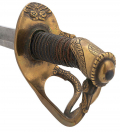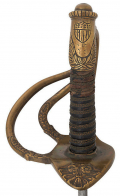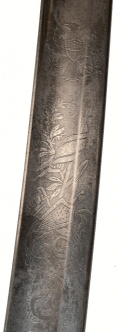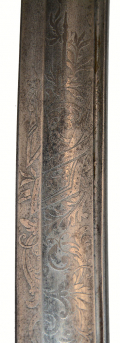site search
online catalog
PRESENTATION M1840 CAVALRY OFFICER’S SWORD OF LT. JAMES H. BRADLEY, ADJUTANT 131st NY – “1st METROPOLITAN GUARD” – “A GALLANT OFFICER”- “FIGHTING FOR RESTORATION TO THE RANK OF WHICH ONE OF THOSE PESTS OF THE SERVICE, A COURT-MARTIAL HAD ROBBED HIM.”

$3,250.00 SOLD
Quantity Available: None
Item Code: 1052-1121
James H. Bradley’s 1864 obituary noted the “death of a gallant officer,” mentioning his presence at First Bull Run, heroics in the peninsula campaign, service in Banks’s Bayou Teche campaign, and later duty as Provost Marshal in the Department of the Gulf, but did omit a court martial that got him dismissed from the service early in his career. His presentation saber is a very good example of a M1840 Heavy Cavalry Officer’s Saber presented to an infantry officer who, as regimental adjutant, would be serving mounted, and was published in Stroud’s “Inscribed Union Swords.” It is also great evidence of the respect and esteem in which he was held by the non-commissioned officers of his new regiment after very publicly redeeming his reputation on the battlefields of Williamsburg and Fair Oaks. The saber is not maker marked, but is certainly a German-made import, bearing an “IRON PROOF” etching on the spine, retailed by a US military goods dealer, and bears an elegant inscription on the obverse of the scabbard between the upper and middle ring bands in a mix of script, block and Old English lettering: Presented to/Lieut. J.H. Bradley/adjt. 1st. M.G. 131st N.Y.S.V./by/the Non. Coms./Sept. 12th, 1862.
The hilt and scabbard are gilt brass. The hilt is the heavy 1840 type and has a notched pommel brim with rounded dome cap, rudimentary US shield on the pommel face and leafy branch around the edge, but with cast and chased floral elements on upper end of the knuckelbow and shallow panels of leafy branches on the guard branches near the counterguard, with a Classical palmette with two rosettes on the quillon face. There are traces of gilt in recesses, but overall it has a pleasing bronze tone. The leather grip shows wear, exposing the cording in some places, mostly near the pommel. The wire is all there, but a tad loose. There are two washers in place on the underside of the guard- a red cloth one with pinked edge with a heavier, buff leather sealing pad on top.
The scabbard is floral engraved gilt brass matching the hilt. The ring bands are cast and chased with overlapping leaves set on floral panels: to either side symmetrical floral fans and addorsed C-scrolls extend toward the hilt and drag. The lower portion of the scabbard is similarly decorated for about a third of the way up from the drag toward the lower ring band. The surface shows fairly even color with muted gilt mixed with patinaed brass. There are two pushes to the scabbard on opposite sides, midway between the lower ring mount and the drag, about where the lower panel of engraving starts.
The blade is etched on the obverse with a stand of arms followed by loose, floral scrolls reaching up to entwine a quiver of arrows, followed by a US eagle with raised wings with an E PLURIBUS UNUM ribbon overhead and finishing with more floral elements and the frosted ground ending in flame points. The reverse has a similar mix of arms, including a U.S. flag near the ricasso, floral scrolls and an ornamented block “U.S.” as the central motif, with more floral entwined arms, including a pike, finishing the panel. The etching is visible and legible though muted by the frosting has shifting toward gray and age spotting.
Bradley was 24 and married when he enlisted May 4, 1861, and and likely had some social standing, gaining a commission and mustering in on May 27 as 1st Lieutenant of Co. D in 31st NY, the “Montezuma Regiment, recruited mostly in New York City. The regiment was engaged at First Bull Run and he must have performed well enough- he is included in the Colonel’s roster of officers in his official report complimenting them all for their performance, and he was in command of the company for two weeks in August. He certainly displeased someone, however, for he faced a court martial in late 1861 that resulted in his dismissal from service, announced in General Orders in March 1862, which ironically made unnecessary his discharge by special orders upon an “adverse report of a Board of Examination.”
Whatever the charges, they were not enough to damn him on the home front and immediately went on a campaign of redemption, gaining a spot as volunteer aide on the staff of Col. J.L. Riker of the 62nd NY, the Anderson Zouaves, - also from New York City and with some court martial. Bradley made himself very noticeable at Williamsburg and at Fair Oaks, steadying the regiment under fire, scouting the enemy advance and taking prisoners in the latter engagement, in which Riker was killed. He then accompanied Riker’s body back to New York City, where he addressed a public meeting regarding Riker’s funeral and was quoted in the newspapers.
A correspondent for the Tribune also recorded his encounter with Bradley on the field at Fair Oaks, referenced the courtmartial as a trivial inconvenience and recounted his bravery on the field:
“In the early part of the action, going near the 62nd, I noticed an adjutant busy in giving tune and time to the regiment for a patriotic song. It was well-for if shell hissed and screamed anywhere, a leetle more discouraging, than elsewhere, it was precisely over the heads of the 62d. I inquired the officer's name, and was told James H. Bradley, a volunteer, fighting here as he did at Williamsburg, for restoration to the rank of which one of those pests of the service, a court-martial had robbed him. This regiment, ordered after a while to the ground where Riker, its Colonel, lost his life, was soon surrounded by the evidences of the coming of the rebels in force. Bradley acted the part of a fighting vidette. He dashed in bis horse at every single figure he saw in the opposite woods, captured and brought them in, returned and repeatedly measured, and then reported the distance the advancing foe were yet from bis regiment.-When Col. Riker was killed, Bradley by his cool, yet desperate courage, served wonderfully to hold bis regiment up to its highest fighting pitch, and won over and over his title to go to the President and say-"the rank of a simple Lieutenant which I fought for at Bull Run, and lost in a court-martial, most unjustly, and fought to recover at Williamsburg, I have again fought for in front of a regiment of brave men, and I respectfully hope I have recovered." Hundreds of men with muskets and bayonets in their hands hope so too.”
Bradley was successful in reestablishing himself, gaining a new commission on Aug. 14, 1862, as 1st Lieutenant and Adjutant of the 131st New York, whose non-commissioned officers presented him with this sword on September 12. The regiment was one of five recruited under the auspices of the New York metropolitan police department, and designated as the “1st Metropolitan Guard,” hence the “MG” in the presentation. Though sometimes referred to as the Metropolitan Brigade, those regiments did not serve together. The regiment served at Annapolis until late 1862 when it was ordered to the Department of the Gulf, was ordered to New Orleans in late 1862. According to his obituary, Bradley served through Banks’s “campaign on the Teche,” but, “having received some injuries at Alexandria, he was appointed to the staff of Gen. Bowen, then Provost Marshal General of the Department of the Gulf, and served in the capacity of Provost Marshal at various localities in this Department until his death, as which time he was Provost Marshal at Donaldsonville.”
Being on the Teche campaign implies he was with the regiment during the prior operations against Port Hudson in March and in the actions at Fort Bisland, Porter’s Plantation, Indian Bend, Irish Bend, Bayou Vermilion, and the march to Opelousas in April, 1863. No date is given for his injuries at Alexandria so it is unclear when he commenced his provost marshal duties and he may have seen more action in the siege of Port Hudson and later operations. We do know, however, that on March 6, 1864, he left the 131st to join the 1s New Orleans Volunteers as Captain of Company H, and had received a commission as Major of the regiment and was awaiting muster when he was taken ill and died of “congestive chills” in New Orleans on Oct. 2, 1864. The regiment was assigned to the defenses of New Orleans and by the time of his death, he had been joined in the city by his wife and children.
This is a strong example of an import M1840 cavalry officer’s saber with an interesting history that could be further teased out. [sr][ph:L]
~~~~~~~~~~~~~~~~~~~~~~~~~~~~~~~~~~~
THIS ITEM, AS WITH ALL OTHER ITEMS AVAILABLE ON OUR WEB SITE,
MAY BE PURCHASED THROUGH OUR LAYAWAY PROGRAM.
CLICK HERE FOR OUR POLICIES AND TERMS.
THANK YOU!
Inquire About PRESENTATION M1840 CAVALRY OFFICER’S SWORD OF LT. JAMES H. BRADLEY, ADJUTANT 131st NY – “1st METROPOLITAN GUARD” – “A GALLANT OFFICER”- “FIGHTING FOR RESTORATION TO THE RANK OF WHICH ONE OF THOSE PESTS OF THE SERVICE, A COURT-MARTIAL HAD ROBBED HIM.”
For inquiries, please email us at [email protected]
Most Popular
Historical Firearms Stolen From The National Civil War Museum In Harrisburg, Pa »
Theft From Gravesite Of Gen. John Reynolds »
Fine Condition Brass Infantry Bugle Insignia »
Selection Of Unframed Prints By Don Troiani »
Wonderful Condition Original Confederate-Manufactured Kepi For A Drummer Boy Or Child »
featured item
VERY RARE US MODEL 1840 AMES CAVALRY OFFICER’S SWORD WITH QUILLBACK SOLINGEN BLADE
Very rare Ames with gold washed, quillback, Damascus blade from Solingen. Manufactured: Springfield, MA / Solingen Maker: N.P.Ames Year: C1840s Model: M1840 Size: 33 5/8 inch blade length, 1.18 wide Condition: Excellent+ This is obviously a product… (870-238). Learn More »






















